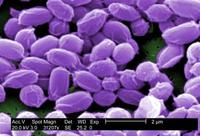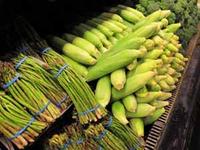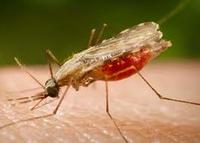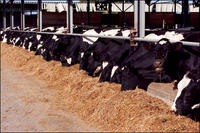-
Thriving in toxic environments
Not long ago, a group claimed that these microorganisms, which live in an environment that is rich in the arsenic-based compound arsenate, could take up that arsenate and use it — instead of the phosphate on which all known life on Earth depends; the claim, since disproved, raised another question: How do organisms living with arsenate pick and choose the right substance? Scientists reveal how bacteria living in toxic environments identify and expel the poison
-
-
Cellphone data helps target likely spots for malaria control
Mosquitoes that carry malaria have a limited flight range, but that does not stop the disease from traveling long distance; humans infected with the disease can carry it anywhere a car or plane can reach; this makes eliminating the disease challenging, especially when limited resources for health care and mosquito control are available to cover a large geographic region
-
-
Researchers find anthrax can grow and reproduce in soil

Anthrax has the unexpected ability to grow and reproduce while lurking in soil — increasing the deadly bacteria’s chances to infect cattle and other mammals; researchers have found that the spores can attack a common soil and water amoeba, Acanthamoeba castellanii, turning these single-celled organisms into anthrax incubators
-
-
New Ebola antibody treatment protects monkeys from lethal disease
A new Ebola virus study resulting from a widespread scientific collaboration has shown promising preliminary results, preventing disease in infected nonhuman primates using monoclonal antibodies; the research team describes a proof-of-concept for using a “cocktail” of monoclonal antibodies, or mAbs, to prevent lethal disease in rhesus macaques; when administered one hour after infection, all animals survived; two-thirds of the animals were protected even when the treatment, known as MB-003, was administered forty-eight hours after infection
-
-
China’s Mekong River dams undermine neighbors’ economies, food production

Five Chinese dams on the Mekong River’s upper portions have caused rapid changes in water level, and other adverse effects, downstream, especially in Vietnam, Cambodia, Thailand, and Laos, where millions of people rely on the river for water, food, and transportation
-
-
Cutting food losses in half would feed an additional billion people
More efficient use of the food production chain and a decrease in the amount of food losses will dramatically help maintaining the planet’s natural resources and improve people’s lives; researchers have proved a valid estimation, for the first time, for how many people could be fed with reducing food losses
-
-
Mathematics offers new weapon in fight against pandemics
Mathematicians have developed a powerful tool to quantify the spread and infectiousness of viruses like the pandemic H1N1 flu strain, a tool which can be used together with modern laboratory techniques to help the healthcare system plan its response to disease outbreaks
-
-
Research on enhanced transmissibility in H5N1 influenza: the debate continues

How can scientists safely conduct avian flu research if the results could potentially threaten, as well as save, millions of lives? Enhancing and analyzing the transmissibility of the H5N1 virus could, on the one hand, provide insights that could help prevent or treat a future outbreak of H5N1, or, on the other hand, it may provide a roadmap for a bad actor deliberately to bring about an influenza pandemic or lead to an inadvertent release of a virus with enhanced transmissibility
-
-
New methods might drastically reduce the costs of investigating polluted sites
In Europe there are over 20,000 complex and large contaminated areas. These so-called megasites threaten scarce land and water resources, create environmental and health risks, and result in economic and social costs; new methods may allow polluted sites to be investigated and monitored long term at significantly reduced costs
-
-
Non-lethal cures: new antibiotic cures disease by disarming pathogens, not killing them
A new type of antibiotic can effectively treat an antibiotic-resistant infection by disarming instead of killing the bacteria that cause it; this is good news, since new drugs are badly needed for treating infections with the bacterium Acinetobacter baumannii, a pathogen that most often strikes hospital patients and immune- compromised individuals through open wounds, breathing tubes, or catheters
-
-
Herbicide-resistant crops require more herbicides
Researchers find that the use of herbicides in the production of three genetically modified herbicide-tolerant crops — cotton, soybeans, and corn — has actually increased; this counterintuitive finding is based on an exhaustive analysis of publicly available data from the U.S. Department of Agriculture’s National Agriculture Statistics Service
-
-
Probability maps help detect food contamination

Researchers demonstrate how developing a probability map of the food supply network using stochastic network representation might shorten the time it takes to track down contaminated food sources; stochastic mapping shows what is known about how product flows through the distribution supply chain and provides a means to express all the uncertainties in potential supplier-customer relationships that persist due to incomplete information
-
-
Entomologists discover new species of malaria-transmitting mosquito

Malaria is the leading cause of death in Kenya, where twenty-five million people out of its population of thirty-four million are at risk; researchers have recently discovered a potentially dangerous new malaria-transmitting mosquito; the as-yet-unnamed, and previously unreported, mosquito breeds in the western areas of Kenya and has an unknown DNA match to any of the existing malaria-transmitting species
-
-
Genetic sleuthing uncovers deadly new virus in Africa
An isolated outbreak of a deadly disease known as acute hemorrhagic fever, which killed two people and left one gravely ill in the Democratic Republic of Congo in the summer of 2009, was probably caused by a novel virus scientists have never seen before
-
-
How vulnerable is the U.S. to agro-terror attack?

Since the 9/11 terrorist attacks, the United States has spent billions of dollars to make the country safer from another catastrophic event, but little of that money, and little attention, have been directed toward preventing, coping with, and recovering from a terrorist agro-attack; how vulnerable is the United States to an attack on its food system?
-
More headlines
The long view
What We’ve Learned from Survivors of the Atomic Bombs
Q&A with Dr. Preetha Rajaraman, New Vice Chair for the Radiation Effects Research Foundation in Hiroshima and Nagasaki, Japan.
Combatting the Measles Threat Means Examining the Reasons for Declining Vaccination Rates
Measles was supposedly eradicated in Canada more than a quarter century ago. But today, measles is surging. The cause of this resurgence is declining vaccination rates.
Social Networks Are Not Effective at Mobilizing Vaccination Uptake
The persuasive power of social networks is immense, but not limitless. Vaccine preferences, based on the COVID experience in the United States, proved quite insensitive to persuasion, even through friendship networks.
Vaccine Integrity Project Says New FDA Rules on COVID-19 Vaccines Show Lack of Consensus, Clarity
Sidestepping both the FDA’s own Vaccines and Related Biological Products Advisory Committee and the CDC’s Advisory Committee on Immunization Practices (ACIP), two Trump-appointed FDA leaders penned an opinion piece in the New England Journal of Medicine to announce new, more restrictive, COVID-19 vaccine recommendations. Critics say that not seeking broad input into the new policy, which would help FDA to understand its implications, feasibility, and the potential for unintended consequences, amounts to policy by proclamation.
Are We Ready for a ‘DeepSeek for Bioweapons’?
Anthropic’s Claude 4 is a warning sign: AI that can help build bioweapons is coming, and could be widely available soon. Steven Adler writes that we need to be prepared for the consequences: “like a freely downloadable ‘DeepSeek for bioweapons,’ available across the internet, loadable to the computer of any amateur scientist who wishes to cause mass harm. With Anthropic’s Claude Opus 4 having finally triggered this level of safety risk, the clock is now ticking.”
“Tulsi Gabbard as US Intelligence Chief Would Undermine Efforts Against the Spread of Chemical and Biological Weapons”: Expert
The Senate, along party lines, last week confirmed Tulsi Gabbard as Director of National intelligence. One expert on biological and chemical weapons says that Gabbard’s “longstanding history of parroting Russian propaganda talking points, unfounded claims about Syria’s use of chemical weapons, and conspiracy theories all in efforts to undermine the quality of the community she now leads” make her confirmation a “national security malpractice.”
